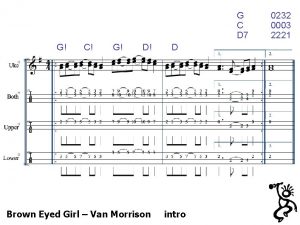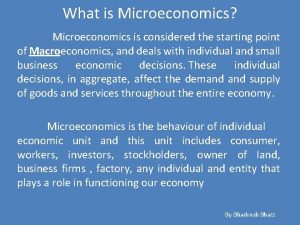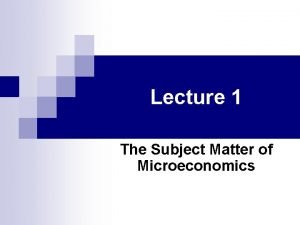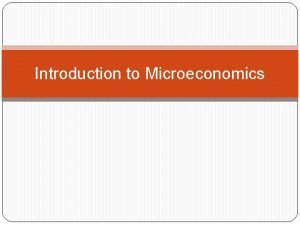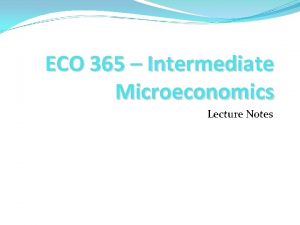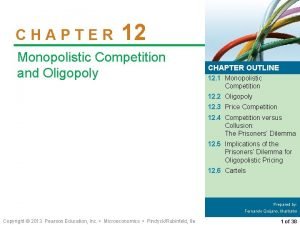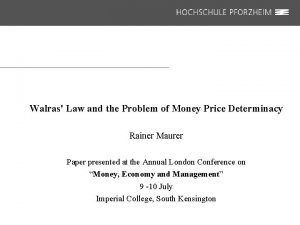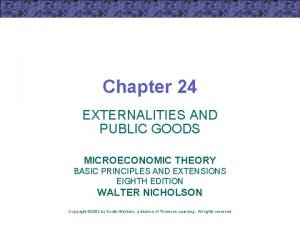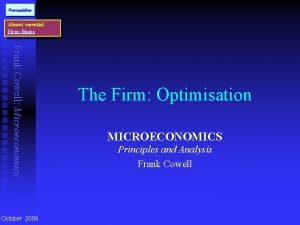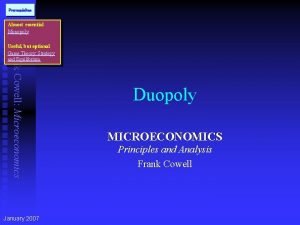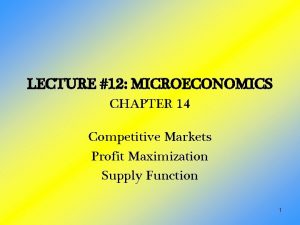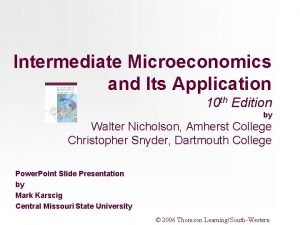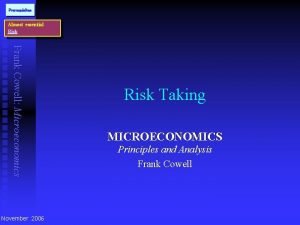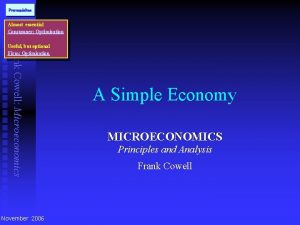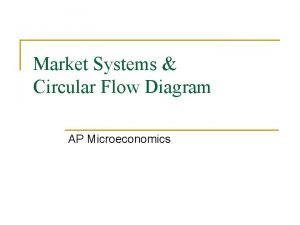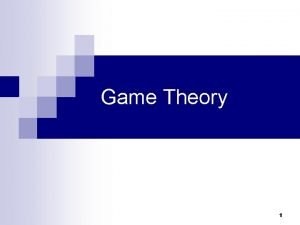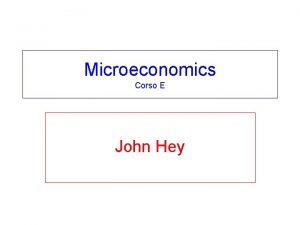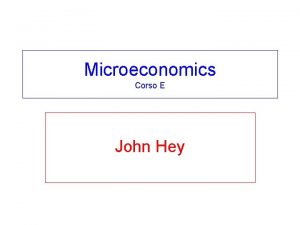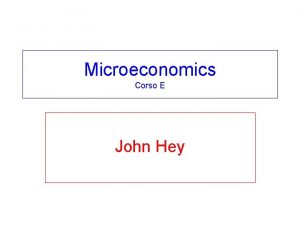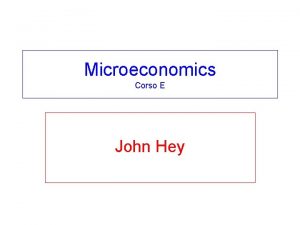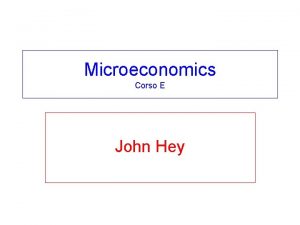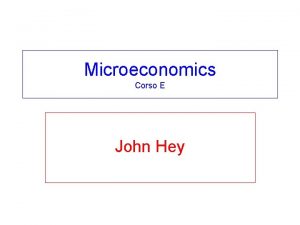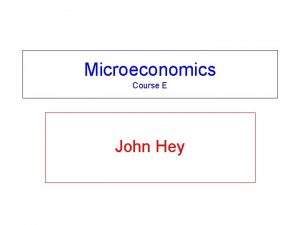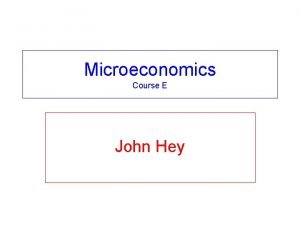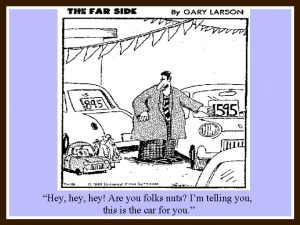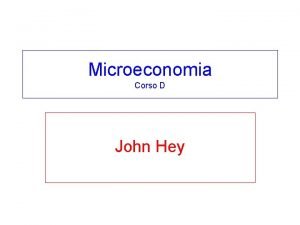Microeconomics Corso E John Hey Summary of Chapter



















![y = [min(q 1, q 2)]2 Perfect Complements 1 with 1 and increasing returns y = [min(q 1, q 2)]2 Perfect Complements 1 with 1 and increasing returns](https://slidetodoc.com/presentation_image_h/c897a23f0b2dbfb53a5726fecf187ea9/image-20.jpg)
![Y = [min(q 1, q 2)]0. 5: Perfect Complements 1 with 1 and decreasing Y = [min(q 1, q 2)]0. 5: Perfect Complements 1 with 1 and decreasing](https://slidetodoc.com/presentation_image_h/c897a23f0b2dbfb53a5726fecf187ea9/image-21.jpg)








- Slides: 29

Microeconomics Corso E John Hey

Summary of Chapter 8 • The contract curve shows the allocations that are efficient in the sense of Pareto. • There always exist the possibility of mutually advantageous exchange if preferences are different and/or endowments are different (unless the endowment point is on the contract curve). • Perfect competitive equilibrium (with both individuals taking the price as given) always leads to a Pareto efficient allocation. • If one of the individuals chooses the price the allocation is not Pareto efficient.


The competitive equilibrium depends on the preferences and the endowments. • If one individual changes his or her preferences in such a way that he or she now prefers more a particular good than before. . . • . . . the relative price of that good rises. • If an individual is endowed with more of a good than before. . . • . . . the relative price of that good falls.

Part 1 and Part 2 • Part 1: an economy without production. . . • . . . just exchange • Part 2: an economy with production. . . • . . . production and exchange.

Part 1 • • • Reservation prices. Indifference curves. Demand supply curves. Surplus. Exchange. The Edgeworth Box. The contract curve. Competitive equilibrium. Paretian efficiency and inefficiency.

Part 2 • Chapter 10: Technology. • Chapter 11: Minimisation of costs and factor demands. • Chapter 12: Cost curves. • Chapter 13: Firm’s supply and profit/surplus. • Chapter 14: The production possibility frontier. • Chapter 15: Production and exchange.

Chapter 10 • • Firms produce. . . they use inputs to produce outputs. In general many inputs and many outputs. We work with a simple firm that produces one output with two inputs. . . • . . . capital and labour. • The technology describes the possibilities open to the firm.

Chapter 5 • Individuals • Buy goods and ‘produce’ utility… • …depends on the preferences… • …which we can represent with indifference curves. . • …in the space (q 1, q 2) Chapter 10 • Firms • Buy inputs and produce output… • …depends on the technology… • …which we can represent with isoquants. . • …in the space (q 1, q 2)

The only difference? • We can represent preferences with a utility function. . . • . . . but this function is not unique. . . • . . . because/hence we cannot measure the utility of an individual. • We can represent the technology of a firm with a production function. . . • . . . and this function is unique… • …because we can measure the output.

An isoquant • In the space of the inputs (q 1, q 2) it is the locus of the points where output is constant. • (An indifference curve – the locus of the points where the individual is indifferent. Or the locus of points for which the utility is constant. )

Two dimensions • The shape of the isoquants: depends on the substitution between the two inputs. • The way in which the output changes form one isoquant to another – depends on the returns to scale.

Perfect substitutes 1: 1 • an isoquant: q 1 + q 2 = constant • y = A(q 1 + q 2) constant returns to scale • y = A(q 1 + q 2)0. 5 decreasing returns to scale • y = A(q 1 + q 2)2 increasing returns to scale • y = A(q 1 + q 2)b returns to scale decreasing (b<1) increasing (b>1)

y = q 1 + q 2 : perfect substitutes 1: 1 and constant returns to scale

y = (q 1 + q 2)2 : perfect substitutes 1: 1 and increasing returns to scale

y = (q 1 + q 2)0. 5 : perfect substitutes 1: 1 and decreasing returns to scale

Perfect Substitutes 1: a • an isoquant: q 1 + q 2/a = constant • y = A(q 1 + q 2/a) constant returns to scale • y = A(q 1 + q 2/a)b returns to scale decreasing (b<1) increasing (b>1)

Perfect Complements 1 with 1 • an isoquant: min(q 1, q 2) = constant • y = A min(q 1, q 2) constant returns to scale • y = A[min(q 1, q 2)]b returns to scale decreasing (b<1) increasing (b>1)

y = min(q 1, q 2): Perfect Complements 1 with 1 and constant returns to scale
![y minq 1 q 22 Perfect Complements 1 with 1 and increasing returns y = [min(q 1, q 2)]2 Perfect Complements 1 with 1 and increasing returns](https://slidetodoc.com/presentation_image_h/c897a23f0b2dbfb53a5726fecf187ea9/image-20.jpg)
y = [min(q 1, q 2)]2 Perfect Complements 1 with 1 and increasing returns to scale
![Y minq 1 q 20 5 Perfect Complements 1 with 1 and decreasing Y = [min(q 1, q 2)]0. 5: Perfect Complements 1 with 1 and decreasing](https://slidetodoc.com/presentation_image_h/c897a23f0b2dbfb53a5726fecf187ea9/image-21.jpg)
Y = [min(q 1, q 2)]0. 5: Perfect Complements 1 with 1 and decreasing returns to scale

Perfect Complements 1 with a • an isoquant: min(q 1, q 2/a) = constant • y = A min(q 1, q 2/a) constant returns to scale • y = A[min(q 1, q 2/a)]b returns to scale decreasing (b<1) increasing (b>1)

y = q 10. 5 q 20. 5: Cobb-Douglas with parameters 0. 5 and 0. 5 – hence constant returns to scale

y = q 1 q 2: Cobb-Douglas with parameters 1 and 1 – hence increasing returns to scale

y = q 10. 25 q 20. 25: Cobb-Douglas with parameters 0. 25 and 0. 25 – hence decreasing returns to scale

Cobb-Douglas with parameters a and b • an isoquant: q 1 a q 2 b = constant • y = A q 1 a q 2 b • a+b<1 decreasing returns to scale • a+b=1 constant returns to scale • a+b>1 increasing returns to scale

Chapter 5 • Individuals • The preferences are given by indifference curves • …in the space (q 1, q 2) • . . can be represented by a utility function u = f(q 1, q 2)… • …which is not unique. Chapter 10 • Firms • The technology is given by isoquants • …in the space (q 1, q 2) • . . can be represented by a production function … y = f(q 1, q 2)… • … which is unique.

Chapter 10 • Goodbye!

 Song with hey hey hey in chorus
Song with hey hey hey in chorus Pictures
Pictures Hey hey you you get off of my cloud
Hey hey you you get off of my cloud Hey hey you you get off of my cloud
Hey hey you you get off of my cloud Hey hey people
Hey hey people Laughing and a running hey hey
Laughing and a running hey hey Microeconomics chapter 12
Microeconomics chapter 12 Hey come on out questions and answers
Hey come on out questions and answers What is microeconomics
What is microeconomics Microeconomics vs macroeconomics venn diagram
Microeconomics vs macroeconomics venn diagram What is the subject matter of microeconomics
What is the subject matter of microeconomics Meaning
Meaning Intermediate microeconomics lecture notes
Intermediate microeconomics lecture notes Intermediate microeconomics notes
Intermediate microeconomics notes Oligopoly model
Oligopoly model Loi de walras
Loi de walras Externalities and public goods microeconomics
Externalities and public goods microeconomics Frank cowell microeconomics solutions
Frank cowell microeconomics solutions Macroeconomics michael parkin 13th edition
Macroeconomics michael parkin 13th edition Venn diagram of macroeconomics and microeconomics
Venn diagram of macroeconomics and microeconomics Objective of microeconomics
Objective of microeconomics Microeconomics
Microeconomics Microeconomics
Microeconomics Uses of microeconomics
Uses of microeconomics Example of macroeconomics
Example of macroeconomics Cowell microeconomics
Cowell microeconomics Frank cowell
Frank cowell Microeconomics examples
Microeconomics examples Circulair flow marketing
Circulair flow marketing Chipotle
Chipotle





